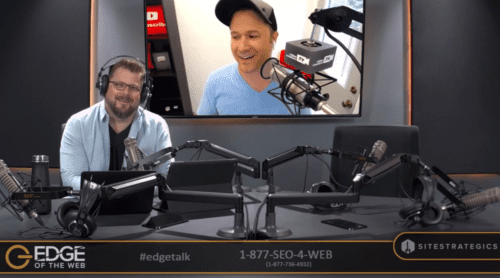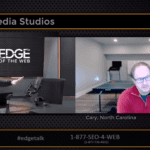Our special guest for episode 319 of the award-winning EDGE of the Web podcast was Tim Schmoyer, Founder and CEO of Video Creators. Site Strategics CEO Erin Sparks spoke with Tim about the importance of having a real YouTube strategy. Here’s what we learned:
Tim Schmoyer: His Background and Experience
Tim Schmoyer is the founder and CEO of Video Creators. He and his team have handled YouTube strategy development for companies like HBO, Warner Brothers, Disney, eBay, Budweiser, and lots of other companies just getting started. Over the year they have actually helped their clients earn more than 14 billion (yes, that’s billion with a “B”) views and 61 million subscribers.
Tim got started with YouTube back in 2006 as a way of introducing his girlfriend to his family across the country. He was using an old 8mm camcorder that used tape, recording and transferring simultaneously to his computer, so the videos were very short. This was back in the days of Windows Movie Maker for editing. His very first video, “Test Video” was uploaded to YouTube on March 22, 2006, and it’s still out there today. His videos were just simple, showing he and his girlfriend (now his wife) going out to eat, going to parks and movies and so forth. Today these would be called Vlogs, but that word didn’t exist back then.
When he noticed other people beyond his friends and family were watching his videos, it raised all sorts of questions, like who are these people? Why are they watching? Why are they commenting? How did they find his videos? Why do they keep coming back for me? Finding answers to these questions seemed important, and Tim realized other people were starting to ask the same kinds of questions. Word spread that Tim was the guy who was working on answering these kinds of questions.
Meanwhile, he eventually married his girlfriend and started a family and they kept making their vlogs and eventually had a million people watching them. That’s when he realized the true power to scale on YouTube and have a real impact in the world, and that he could help other people and companies have that kind of impact. That’s when he started Video Creators, a company devoted to helping people and companies grow on YouTube through strategy development – not just to make money or be popular, but changing people’s lives.
YouTube: It’s About Storytelling

Everyone talks about the need for marketing to become more authentic. A return to authenticity is certainly important, but it’s only a part of what’s needed for YouTube success. There are a lot of different elements that go into branding.
What happens to a lot of people is they approach YouTube as a marketing tool and proceed to carefully craft all their keywords and metadata and titles and thumbnails and so on. From an SEO perspective, the YouTube video is perfect. And then it goes nowhere. Tim was once contacted by a vegan company that had spent well over $500,000 producing weekly YouTube videos with truly amazing production values for a whole year. The quality was incredible. But their question for Tim was why their top video had a grand total of 24 views. Meanwhile, a guy sitting in his basement with a webcam is getting millions of views. What gives?
The hard truth is that YouTube success isn’t about high production values or SEO perfection. It’s about the depth of human connection you can forge. You can’t approach YouTube the same way you approach Google. They’re very different landing pages requiring very different strategies. YouTube is primarily a browsing platform. People browse videos and watch what they want to watch. The relationship between Google and YouTube is critical. You have to figure out how to tell Google who this video is for so they can put it in front of the right people.
But there are all kinds of mechanisms on YouTube besides search that get results in terms of getting views and watch-time. But at its core, you’ve got to figure out how to connect with people so they will spend enough time watching a given video for it to perform well. And this is where storytelling comes in. You have to tell a story in a way that not only conveys the information people want but also tells the story in such a compelling way that they want to watch another one.
7 Key Questions on 3 Levels
When it comes to content level, Tim asks 7 key questions to his client about a video:
- Who is the character?
- What does that character want? The story will revolve around this answer and whether they get want they want or not.
- Why can’t the character get what they want? This is about the obstacles and barriers holding them back.
- What are the stakes? In other words, what will it cost this character if they don’t get what they want? Many people miss this one, and without it the story falls flat.
- Who or what comes along to help them succeed?
- How does the character ultimately get what they wanted? But this is not the end!
- How are they changed as a result? This seventh question is another that many people miss, and it’s the difference between a story people like and a story they love. What people really want to experience is how the character is different now than at the beginning of the story.
And then you’ve got to understand all of this on two other levels, including understanding your audience’s story and their needs, as well as your company story and its goals.
An Example: The Disastrous Lawn
Let’s say you’re going to do a video about weeding your garden or lawn. If all you do is present the technique of how to properly pull a weed so you get it out by its roots, this kind of just-the-facts how-to content simply doesn’t perform well because it doesn’t connect or tell a story.
Instead, you would start by showing your own lawn and what a mess it is and how you wish it didn’t have all these weeds. You want them gone. Then you look over to your neighbor’s lawn and it looks great. So in the video, you visit the neighbor and ask about how they got their lawn to look so fantastic. They explain what they did and then you go and do it to your lawn. The stakes (question #4) could be something like your wife is upset and wants it done, you’re embarrassed by your lawn, the local homeowners association might put a lien on your house if you don’t take better care of the lawn, and so on (the stakes can be internal and/or external). Taking the time to develop a robust storytelling approach will definitely perform much better than how-to content without a good story.
If you’re doing a whole series of videos, the interesting thing is that the same structure applies not only to each individual video, but also the series as a whole. Applying the structure to a series is how you get people to keep watching multiple episodes.
Tim did an experiment with his own videos where instead of talking to an expert and asking for three key tips to get a million subscribers in one year, he would ask the expert to tell the story of how they got a million subscribers in one year. Putting the two approaches side-by-side, the storytelling approach videos get double the watch time, double the retention, quadruple the engagement, and typically around 10X the views compared to the non-storytelling videos. It’s crazy but true. Unvarnished content and bullet points and tips do not perform well. Storytelling does. But if you skip a key question, like the critical what-are-the-stakes question, then even the storytelling video will fall flat and the unvarnished content will outperform it. You’ve got to hit all seven questions.
Connect with Tim Schmoyer and Video Creators
Twitter: @timschmoyer (https://twitter.com/timschmoyer)
LinkedIn: https://www.linkedin.com/in/timschmoyer/
YouTube: https://www.youtube.com/videocreators
Facebook: @videocreators (https://www.facebook.com/videocreators)
Podcast: https://videocreators.com/podcast
Website: https://videocreators.com
Is Your Digital Marketing ROI Everything it Could Be?
Time to get a grip on your digital marketing ROI? Get it done with a Site Strategics report examining your SEO, content, social media, and PPC. Visit https://edgeofthewebradio.com/roi/ to get 30% off a comprehensive review of your digital assets!


